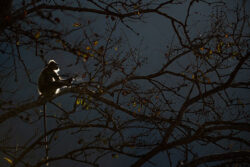Watching a deciduous forest transition from winter to spring, and finally into summer within a short span of 2-3 months is one of the best wilderness experiences in South India.
By the end of January, most of the semi-deciduous trees shed their leaves and the forest floor adorns a carpet of dry leaves. As animals walk on this carpet, the sound of crackling leaves echoes through the forest. I have spent many afternoons listening to this sound, trying to identify the animal just by its specific sound pattern, before it breaks cover.

Dry leaf litter heralds the arrival of summer
Gradually, as we progress into the months of February and March, many of the bare trees begin to bloom, bringing the green back to the canopy.

Sambar Deer (Rusa unicolor)
One such iconic tree that flowers just around the summer is the Flame of the Forest (Butea monosperma). The forest appears lit up by the fiery orange blooms.

Flame of the Forest (Butea monosperma) in bloom
Leaf flushing in trees is an interesting physiological response to the seasonal changes and the Terminalia bellirica, locally known as Taare Mara, goes into a red flush during this time of the year.
The red colouration is primarily due to the presence of anthocyanins. Several hypotheses have been put forward to explain red leaf flushing in trees and one such suggests that the red colouration may make the new leaves less likely to be attacked by insects and may reduce light stress or fungal attacks on leaves.

A male Indian Peafowl (Pavo cristatus) perched on a Terminalia bellirica in flush
Erythrina trees come into bloom, causing another nectar and colour riot and attracting several species of birds.

A babbler on an Erythrina tree
As April approaches, water levels in the backwaters of River Kabini recede. Fresh grass sprouts and elephants from all over the Nilgiri biosphere congregate in the backwaters.

Indian Elephants feeding on fresh grass on the backwaters of River Kabini
The backwaters hold enough water for these elephants to get through the summer months and they vacation here until the monsoons. Boat safaris are the best way to explore the backwaters; with these many elephants in one place, action is guaranteed.

A lone tusker
By May, the forest is bone dry.

Spotted Deer or Chital (Axis axis)
The intense heat is felt by every single being in the forest. Langurs gather around every little spot of shade available, tree-dwellers indulge in siestas under shady branches, water is scarce and animal temperaments are clearly on edge.

Langurs seek a spot away from the sun

An Indian Giant Squirrel (Ratufa indica) rests on a shady branch

Indian Leopard

Bengal Tiger
For peafowl, however, summers are the times of flamboyance. The month of May is peak courtship season for them and the male birds grow their tail feathers to the fullest, putting on a performance at every turn in the jungle.

A male Indian Peafowl (Pavo cristatus)
These vibrant displays continue until the monsoons, hence the common notion that their performances mark the arrival of rain.

A male Indian Peafowl (Pavo cristatus) attempts to impress females
If one would ask me which is the best time to see a forest, quite simply, there is no ‘one best time’ to be in a forest. To really see a forest is to see it go through all the seasons gracefully.





Instagram
junglelodgesjlr